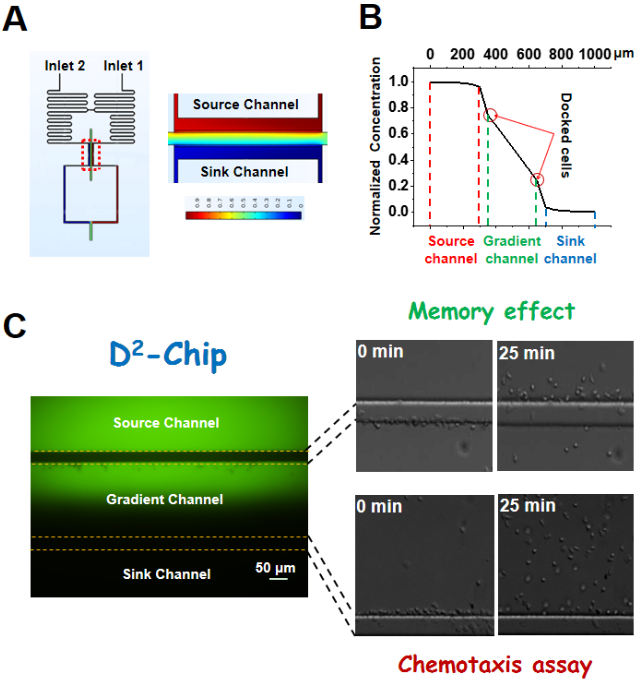
Recently, Prof. LIU Yong's lab from Institute of Applied Technology, Hefei Institutes of Physical Science works closely with Prof. Francis Lin's Immunotrafficking lab at the University of Mani'oba, Canada, to investigate neutrophil chemotaxis and the memory effect by using a dual-docking microfluidic cell migration assay (D2-Chip).
Chemotaxis is a classic mechanism to guide cell migration as well as an important topic in both fundamental cell biology and health sciences. While it is tempting to model neutrophil chemotaxis by using the well-established biased random walk theory. However, the experimental proof was challenged by the cell's highly persistent migrating nature. Therefore, a special experimental design is required to test the key predictions from the random walk model.
Besides, another question about the existence of chemotactic memory and its underlying mechanism has interested the cell migration community for decades.
Although chemotactic memory has been reported in previous studies, a clear quantitative experimental demonstration still remains in need to deepen the understanding of migratory memory effect.

(A) Heat map of the simulated concentration field in the bridge channel, and the parallel gradient channel, source channel and sink channel; (B) Simulated gradient profile in the parallel gradient channel, source channel and sink channel; (C) The fluorescent image of the parallel gradient channel, source channel and sink channel (Image by IAT)
Motivated by these questions, the team developed a microfluidic cell migration assay (so-called dual-docking chip or D2-Chip) that can test both the biased random walk model and the memory effect for neutrophil chemotaxis on a single chip which is enabled by multi-region gradient generation and dual-region cell alignment.
The D2-Chip consists of a middle gradient channel, which is sandwiched by an outer source channel and an outer sink channel, and the source/sink channels are connected to the middle gradient channel by thin barrier channels (Fig. 1A).
Gradient generation in the D2-Chip was verified by both Multiphysics modeling and the experiments (Fig. 1A). The modeling result shows the expected linear gradient in the middle channel (Fig. 1B).
Upon loading the cells into the middle gradient channel through the cell loading port, cells were pushed toward either side of the channel edge due to the pressure difference between the middle channel and the source/sink channels.
This unique feature helps to monitor the time-evolvement of diversified chemotactic migration among cells with the same initial condition. This is predicted, not exclusively, by the biased random walk model, which assumes a chemoattractant gradient dependent migratory bias at each time step while the accumulated statistical variation over time will result in de-synchronization of chemotactic migration for different cells (Fig. 1C).
These experimental observations were conceptually reproduced by computer simulations based on the biased random walk and receptor-based gradient sensing model. In the same set of experiments, the team monitored the migration of cells aligned by the source channel in response to the fMLP fields in the barrier channel and the source channel.
Then this chemotactic memory, if it exists, can be revealed by characterizing the cell’s continued directional migration in the uniform fMLP field in the source channel.
Using a new microfluidic device with the dual cell docking feature, the team provided evidence to support the biased random walk as a possible mechanism for neutrophil chemotaxis and clearly demonstrated chemotactic memory.
Their work highlights the possible biophysical mechanism employed by neutrophils for directional migratory response to their guiding chemical microenvironment and integrates the microfluidics approach to address cell migration questions.
Their work was accepted as back cover of Integrative Biology entitled A dual-docking microfluidic cell migration assay (D2-Chip) for testing neutrophil chemotaxis and the memory effect.

86-10-68597521 (day)
86-10-68597289 (night)

52 Sanlihe Rd., Xicheng District,
Beijing, China (100864)

